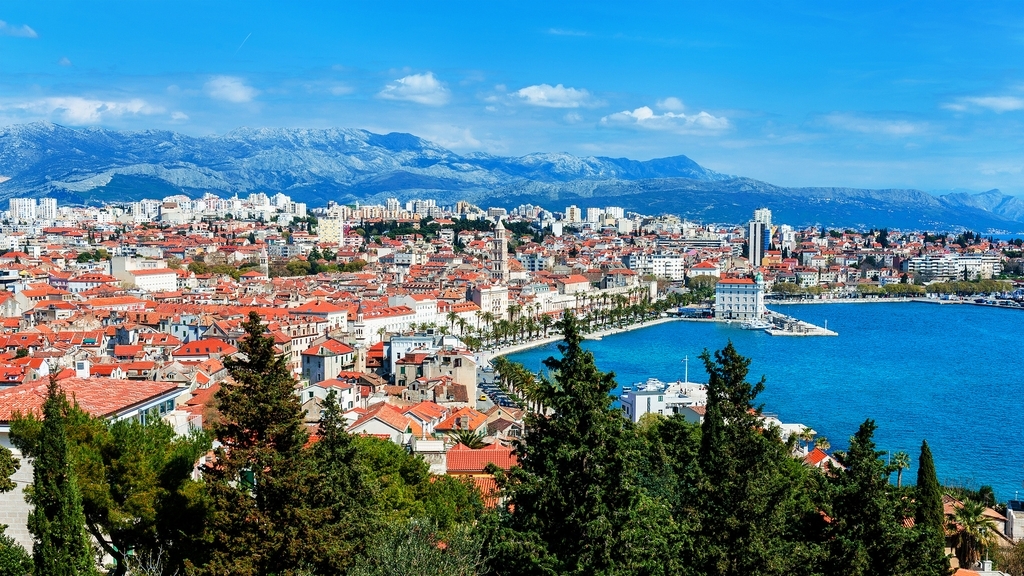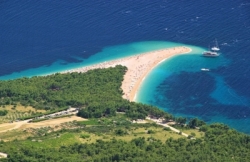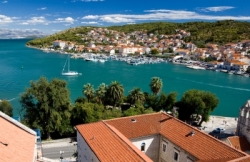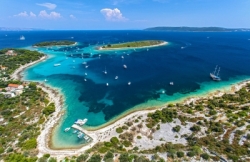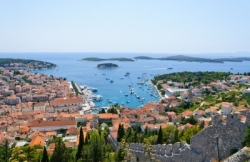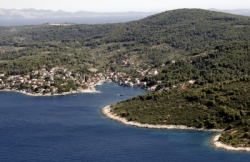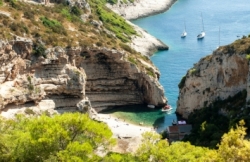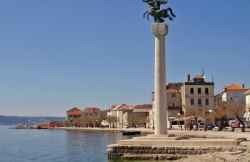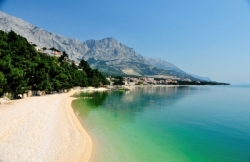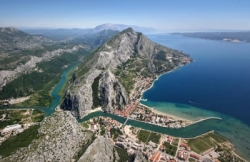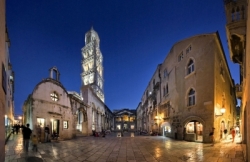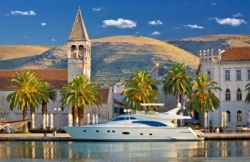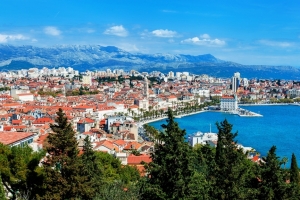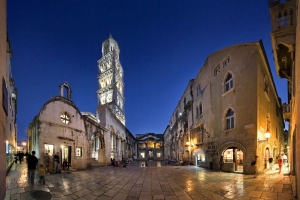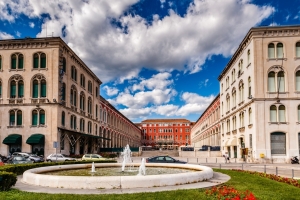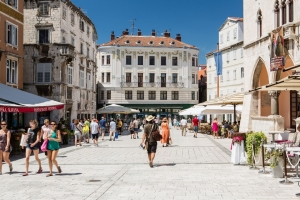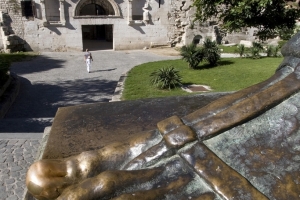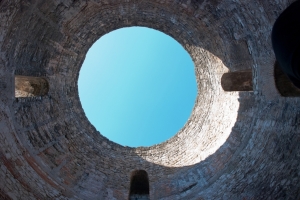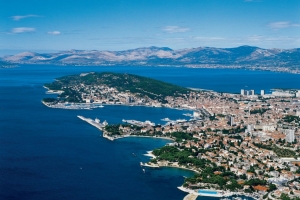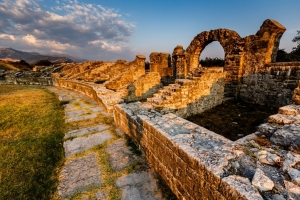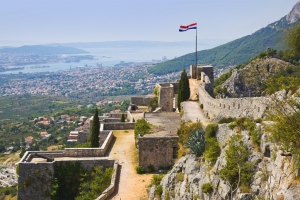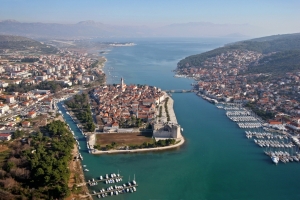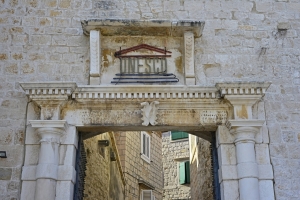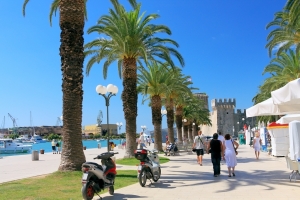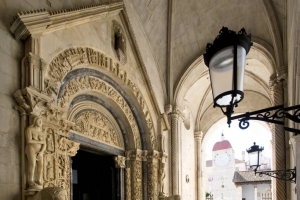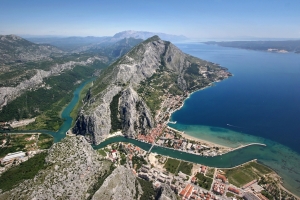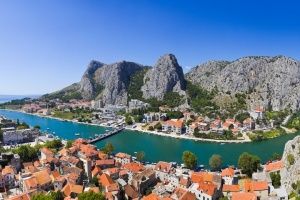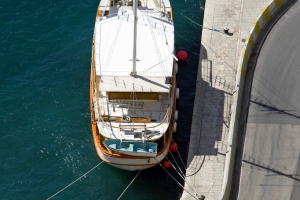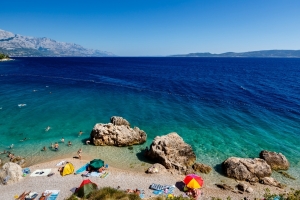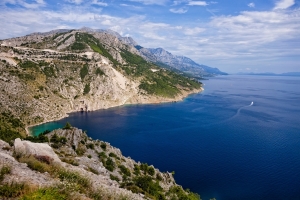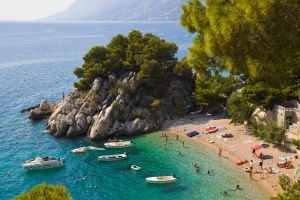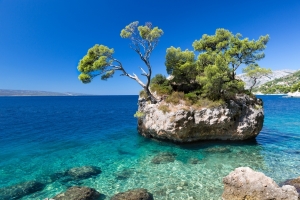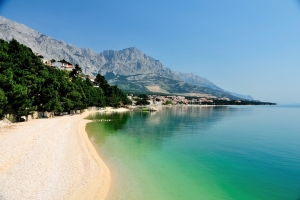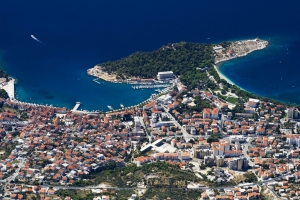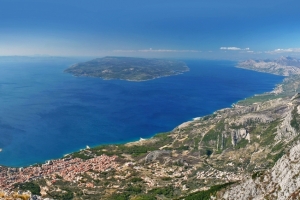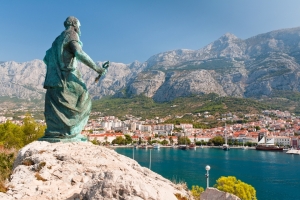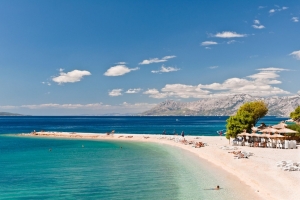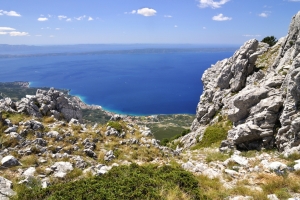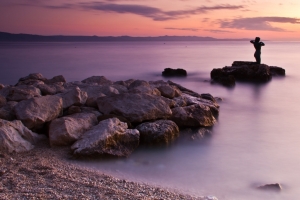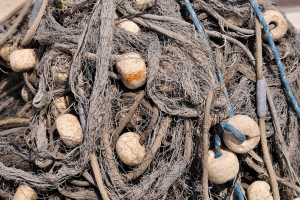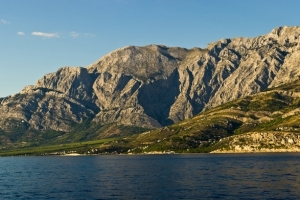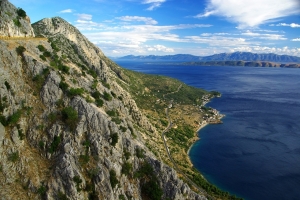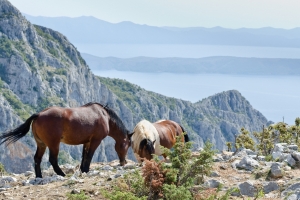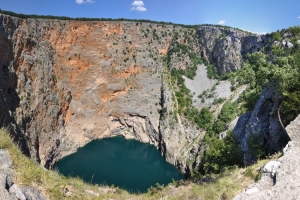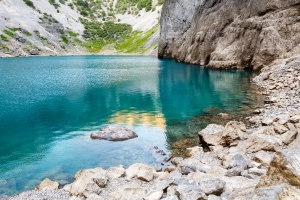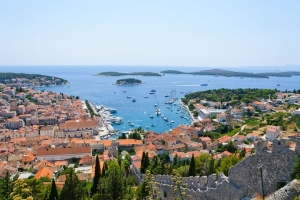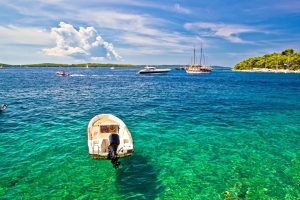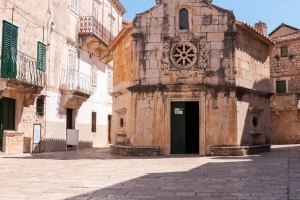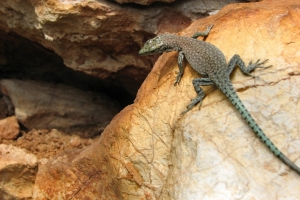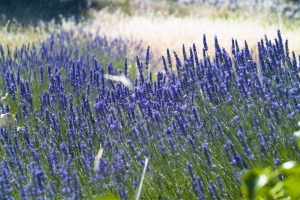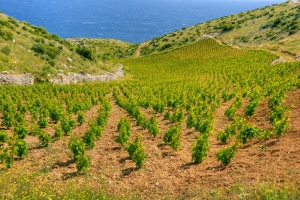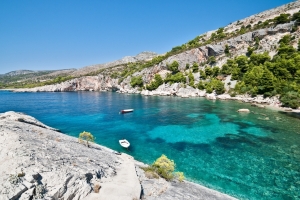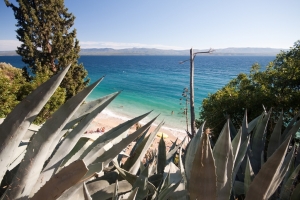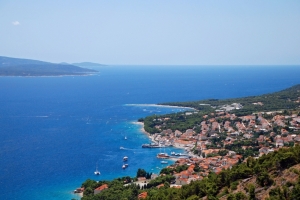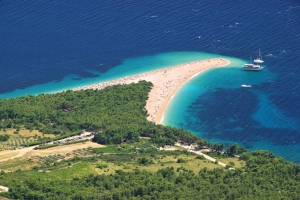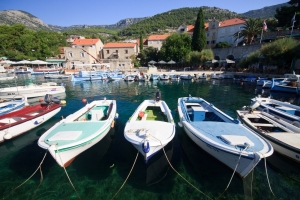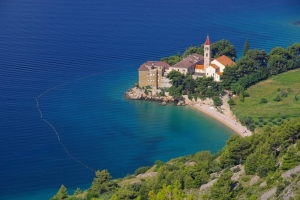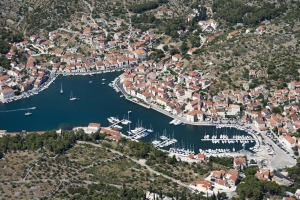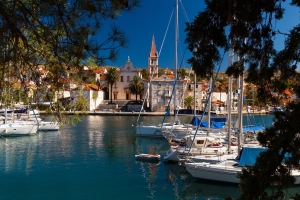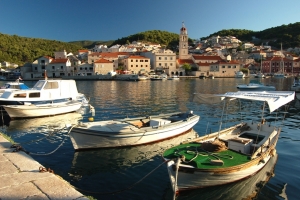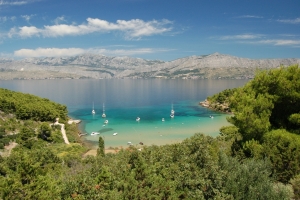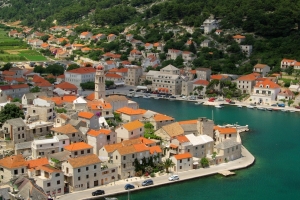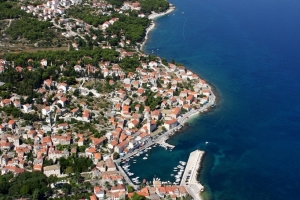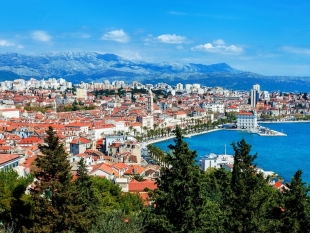


Central Dalmatia: Rough Mountain Landscape Against the Enchanting Adriatic
The imposing Diocletians Palace in Split, the former retirement home o the Roman emperor Gaius Valerius Aurelius Diocletian is just one of many sites which share the UNESCO World Heritage title. In this region one comes across many breathtaking scenes: the old town of Trogir, which is also classified as an UNESCO World Heritage site, the illuminated promenade at night shimmering in the Adriatic Sea, the Biokovo wildlife park from whose rugged peaks the view of the deep blue Adriatic and the Makarska Riviera bewitches visitors. The well-known “Golden Horn” beach in Bol on the island of Brac boasts a wide sea beach rising from the waters whose point can be seen either on one side or the other depending on the tides. These are just some of the attractions of the central Dalmatia region. One of the most popular holiday spots in central Dalmatia is the Makarska Riviera which stretches from the west by Marina and makes its way towards Trogir, Split and Omis, all the way until Gradac on the southern point. This region, with a population of 463,000 includes both islands, such as Hvar and Brac, Vis and Solta, and beautiful beaches such as Punta Rata beach in Brela, which in 2003 was recognized and named as one of the most beautiful beaches in the world.
Split: The Thriving Hub of Central Dalmatia
With its rich historical heritage and famous Diocletian's Palace (UNESCO World Heritage), the promenade “Riva” along the coastline, as well as being the largest main ferry port in the region, Split is not only the undisputed capital of central Dalmatia, but also a very culturally interesting place. A variety of museums, exhibitions, and -especially in summer- outdoor events and, last but not least, the old town architecture influenced by the Roman and Venetian rulers tell of the rich culture and history of the second largest city in Croatia. Split not only attracts locals and visitors for its good shopping, but also for its sporting events. The football club, Hajduk Split, has a very pleased and large fan base all over Dalmatia and is the second most successful football club in Croatia.
Split offers its visitors cultural events and historic buildings, but for those looking to escape, it also has pure nature. Relax in the wooded hills of Marjan located on the peninsula in the west of the city or on one of the idyllic beaches framed by a green oasis of peace and tranquility. There is also a zoo in Split for animal lovers. From the large ferry port of the city you can travel to the nearby islands of Hvar, Brac, Solta, Vis and Korcula, as well as to Rijeka in the Kvarner Bay or to Ancona in neighboring Italy.
Relaxation Away From the Large Tourist Centers
On the island of Brac, there is the famous Bol holiday resort which is home to the most beautiful beach on the Adriatic, Zlatni Rat beach, or in English, the “Golden Horn”. It gets its name from its crescent shaped, long pebbled beach that projects itself into the sea. Its location overlooking the neighboring island of Hvar on the south side is heavenly. The island of Brac is also well-known for its excellent wines and flourishing vineyards, its lively summer culture, as well as with its high quality marble-like limestone. The White in Washington D.C. and the New Hofburg in Vienna are only a few of the many buildings where this beautiful limestone has been used. West of the island of Brac is Solta, a densely wooded island whose rough south side is uninhabited and hardly accessible. The north part of Solta, however, is gorgeous and its idyllic beaches have not yet been affected by mass tourism.
The island of Hvar, lying south of Brac, thrills tourists with its mild and sunny climate and its wonderful lavender fragrance, which was once the most important source of income for the islanders. The vast lavender fields dominate the island images as well as hills full of olive trees and dense pine forests. In addition to the fashionable main city of Hvar, Stari Grad belongs to the list of popular destinations. Here you can also visit a UNESCO World Heritage Site: the agriculturally-used plains east of the village. The area was settled and cultivated by Greeks in 4th Century BC and the primitiveness of these plains has still been maintained today.
Central Dalmatia includes other notable islands such as Vis, whose most important cities are Vis and Komiza. The island of Vis was closed to the public until 1989 and because of this, you can still find original, traditional villages and unspoiled nature full of vineyards, wild herbs, and carob trees. Swimmers and boaters especially enjoy a visit to the famous Stiniva Bay to see it nestled among wildly romantic towering cliffs and the bay's narrow opening to the sea. Here your are definitely far away from mass tourism just like in the Stoncica Bay lying in the northeast. Unlike many places in Croatia, the beach in the Stoncica Bay is sandy. Surrounded by Mediterranean vegetation and crystal clear water there is no reason not to experience pure relaxation here.
From Medieval Trogir to the Once “Gloomy” Pirate Nest of Omis
Another important cultural and historical stronghold in central Dalmatia is Trogir, located west of Split. Trogir's old city is situated on a small island which is connected via a bridge to the mainland and also to the island of Ciovo. Its ferry port makes Trogir an ideal starting point for trips to the nearby islands of Veli Drvenik and Mali Drvenik to the south of Ciovo or also to Split. Palaces, churches and houses from the Romanesque, Gothic, Renaissance and Baroque shape the image of the historic center of Trogir, which has also been a UNESCO World Heritage Site since 1997. A few distinctive buildings to this Romanesque old city are St. Lawrence Cathedral, the city loggia, the Rector's Palace and the Kamerlengo Fortress, which is one of many fortresses and castles in central Dalmatia. Other castles are located to the east along the coast, as well as in Klis in the hinterlands of Split. The fortress of Klis during the middle ages was designated as the “Key of Dalmatia” because of its important strategic position.
Sinj, situated a few kilometers inland is especially famous for its annual medieval games, “Sinjska Alka”. The medieval equestrian tournament has already been a tradition since 1715 in commemoration of the people's victory over the Ottomans. The river Cetina flows through the plains of Sinj and is a popular destination for Rafting, canoing, fishing, para-gliding, rock climbing, canyoning and much more. The river takes its course through of a breathtaking canyon and ends after stretching for nearly 100 kilometers in Omis at the Adriatic Sea. The sensation at the foot of the towering cliffs is Omis, which has itself a very interesting story. The two fortresses of Mirabela and Fortica are reminders of Omis' once dreaded past as a pirate's nest. In numerous events and exhibitions, especially in summer, residents tell of their ancestors with pride, as they were the most feared pirate's in the region. Along the Cetina river near Omis, you can enjoy the delightful local cuisine in one of the many restaurants. In addition to tasty fish dishes and seafood, you should definitely try “Peka”. Peka is a typical Croatian dish of meat, vegetables and fish which is cooked in a cast iron bell jar over a flaming fire for over 2 hours. For a dip in the sea, head to the sandy beaches in Omis or to the various sandy beaches in the neighboring village Duce. The sandy beaches in both Duce and Omis fall very gently into the sea, which is why they are so popular with families with small children. These beaches provide chairs, rental lockers, as well as restaurants and bars for big and small appetites.
Impressive Mountain Scenery on the Beautiful Makarska Riviera
In the south of central Dalmatia, the imposing, rough Biokovo mountain range begins to rise from the earth. Its highest peak reaches 1800 meters to the sky and makes the heart of every hiker beat faster. Hikers can take day trips or smaller hikes through the dense network of hiking trails which vary in difficulty and length. In the mountains, hardy, hiking experts can recuperate in the overnight cabins here. Nature has been very generous in this part of central Dalmatia because the mountains rise, impressively, directly from the coast, and also provide excellent views of the Adriatic and surrounding area. The Biokovo Wildlife Park is also a host to numerous endemic plants and animals.
The Biokovo mountain range separates the stunning Makarska Riviera with places such as Brela, Baska Voda and Tucepi, from the green hinterlands where Imotski is located. Lying near to this cozy city are two seas, the Blue and the Red, which abruptly fall into the rugged earth. The Red Sea gets its name from its reddish cliffs and is located in a 500 meter deep sinkhole. Fascinating both tourists and locals alike, the Blue Sea is a true summer attraction and, when it occasionally dries out, it serves as a venue for soccer tournaments.
The Makarska Riviera is not without a reason, one of the most stunning holiday regions in Croatia. It boasts colorful stone houses, bobbing fishing boats in the harbor, the rugged mountains of Biokovo in the background, white pebble beaches and crystal-clear sea. “Punta Rata”, which was among the ten most beautiful beaches in the world in 2003, is in the Brela resort. From the depths of the turquoise waters, the legendary landmarks of Brela arise: the cliffs. The beach from Baska Voda offers a bit more entertainment. All along the white pebbled, pine tree-lined beaches, are stands offering tourists activities for leisure and sport and also shopping.
Among other heavenly tourist spots are Tucepi, Podgora and Gradac in the south of central Dalmatia. Beautiful beaches can be found in these places as well as savory dishes from the local kitchen, and cultural events on warm summer evenings. The small fishing village of Graday has the longest beach in the region. You can indulge in bathing delights in the the 6 kilometer long Adriatic beach-side. At night you should definitely stop in one of the traditional restaurants and sample typical dishes, such as the Neretva-styled fish stew or grilled eel. All the fish specialties along the Makarska Riviera have a long tradition, which is basically a result of former widespread fishing. Bobbing fishing boats still dominate the ports of the panoramic towns on the Adriatic Sea. Fishing, however, is still a very family- operated business. Due to this, there are many fine fish restaurants in the area of Makarksa and even many events and festivals dedication to the fishing tradition.
In principle, when you look back into history, tourism has had a long tradition in this region. This means that the infrastructure is very well developed and nothing is ever found lacking during the summer holidays. Events and nightlife are as varied as the shopping centers and leisure facilities. Whether hiking, climbing, or mountain biking in the Biokovo mountains, sailing, diving, or swimming in the Adriatic, riding, cycling or playing beach volleyball on the land, tourists can find many exciting activities for a fun-filled holiday in central Dalmatia.
chiudereSottoregioni
Posizione
Totale trovato: 11
Why Best of Croatia ?
- Best Price Guaranteed
- No booking fees
- Thousands of satisfied customers
- Numerous objects with direct-booking option
- Intelligent search function with numerous useful filter options
- Extensive travel guide with lots of pictures and videos over 500 pages
- Detailed beach guide with more than 700 beaches







 Best of Croatia
Best of Croatia









